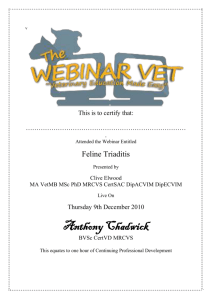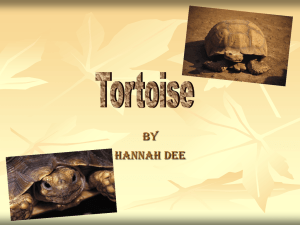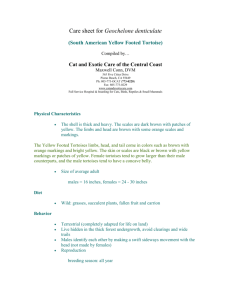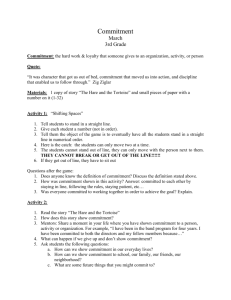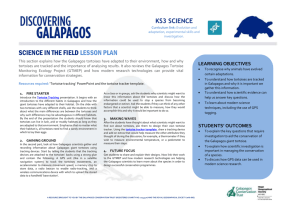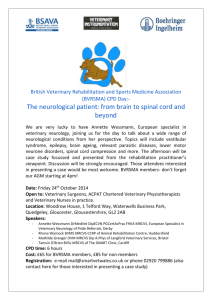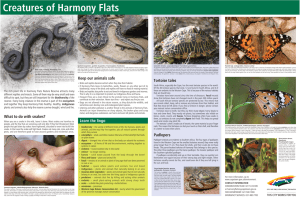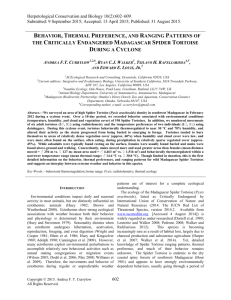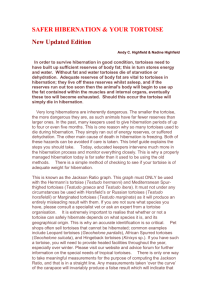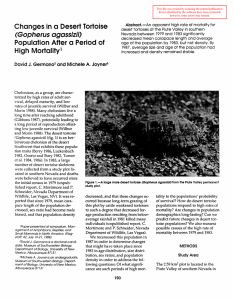Accommodation requirements
advertisement
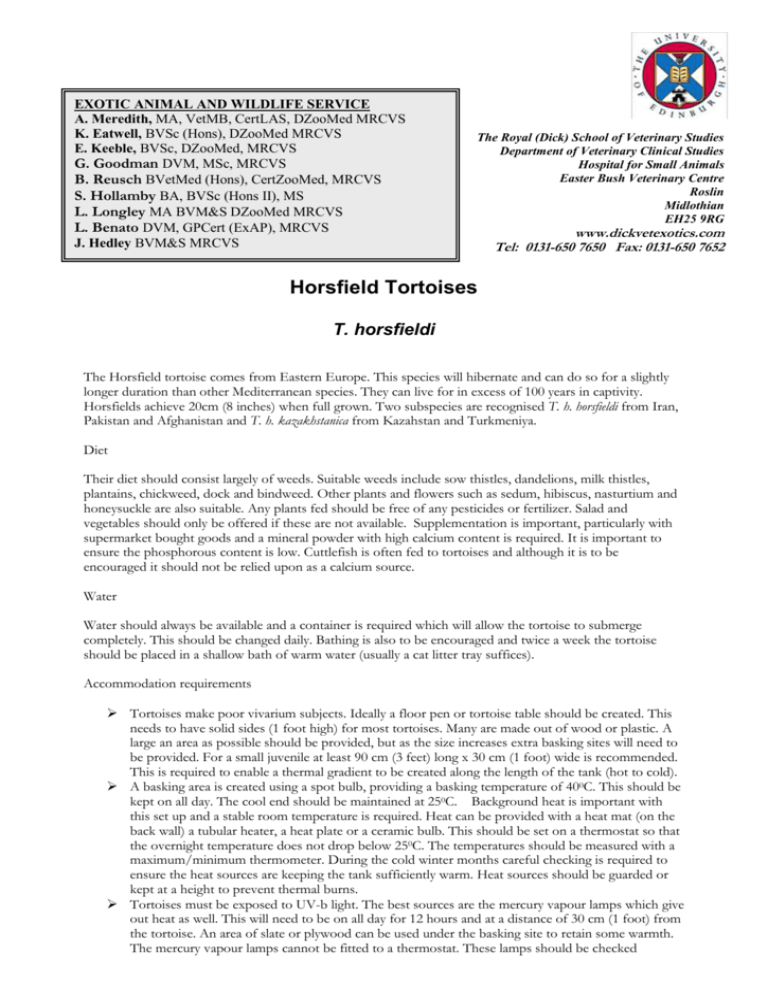
EXOTIC ANIMAL AND WILDLIFE SERVICE A. Meredith, MA, VetMB, CertLAS, DZooMed MRCVS K. Eatwell, BVSc (Hons), DZooMed MRCVS E. Keeble, BVSc, DZooMed, MRCVS G. Goodman DVM, MSc, MRCVS B. Reusch BVetMed (Hons), CertZooMed, MRCVS S. Hollamby BA, BVSc (Hons II), MS L. Longley MA BVM&S DZooMed MRCVS L. Benato DVM, GPCert (ExAP), MRCVS J. Hedley BVM&S MRCVS The Royal (Dick) School of Veterinary Studies Department of Veterinary Clinical Studies Hospital for Small Animals Easter Bush Veterinary Centre Roslin Midlothian EH25 9RG www.dickvetexotics.com Tel: 0131-650 7650 Fax: 0131-650 7652 Horsfield Tortoises T. horsfieldi The Horsfield tortoise comes from Eastern Europe. This species will hibernate and can do so for a slightly longer duration than other Mediterranean species. They can live for in excess of 100 years in captivity. Horsfields achieve 20cm (8 inches) when full grown. Two subspecies are recognised T. h. horsfieldi from Iran, Pakistan and Afghanistan and T. h. kazakhstanica from Kazahstan and Turkmeniya. Diet Their diet should consist largely of weeds. Suitable weeds include sow thistles, dandelions, milk thistles, plantains, chickweed, dock and bindweed. Other plants and flowers such as sedum, hibiscus, nasturtium and honeysuckle are also suitable. Any plants fed should be free of any pesticides or fertilizer. Salad and vegetables should only be offered if these are not available. Supplementation is important, particularly with supermarket bought goods and a mineral powder with high calcium content is required. It is important to ensure the phosphorous content is low. Cuttlefish is often fed to tortoises and although it is to be encouraged it should not be relied upon as a calcium source. Water Water should always be available and a container is required which will allow the tortoise to submerge completely. This should be changed daily. Bathing is also to be encouraged and twice a week the tortoise should be placed in a shallow bath of warm water (usually a cat litter tray suffices). Accommodation requirements Tortoises make poor vivarium subjects. Ideally a floor pen or tortoise table should be created. This needs to have solid sides (1 foot high) for most tortoises. Many are made out of wood or plastic. A large an area as possible should be provided, but as the size increases extra basking sites will need to be provided. For a small juvenile at least 90 cm (3 feet) long x 30 cm (1 foot) wide is recommended. This is required to enable a thermal gradient to be created along the length of the tank (hot to cold). A basking area is created using a spot bulb, providing a basking temperature of 400C. This should be kept on all day. The cool end should be maintained at 250C. Background heat is important with this set up and a stable room temperature is required. Heat can be provided with a heat mat (on the back wall) a tubular heater, a heat plate or a ceramic bulb. This should be set on a thermostat so that the overnight temperature does not drop below 250C. The temperatures should be measured with a maximum/minimum thermometer. During the cold winter months careful checking is required to ensure the heat sources are keeping the tank sufficiently warm. Heat sources should be guarded or kept at a height to prevent thermal burns. Tortoises must be exposed to UV-b light. The best sources are the mercury vapour lamps which give out heat as well. This will need to be on all day for 12 hours and at a distance of 30 cm (1 foot) from the tortoise. An area of slate or plywood can be used under the basking site to retain some warmth. The mercury vapour lamps cannot be fitted to a thermostat. These lamps should be checked regularly for their UV output and should be changed at least annually. It is important to expose your tortoise to natural UV light during the summer months and building an outside enclosure is a requirement for the long term health or your tortoise. Hides are required to provide some security. For tortoises, cardboard boxes, plant pots, logs or commercially available hides can be used. They should be placed both at the warm and cooler ends of the pen. Substrates suitable for housing tortoises include newspaper, Astroturf and some of the commercially available substrates. It is important that the substrates either cannot be eaten, or if they are, do not cause blockages as this can prove fatal. Wood chip based substrates should never be used for this reason. Natural substrate such as soil can be used and are best provided in a cat litter tray for digging. The pen should be cleaned out at least weekly and a suitable disinfectant used. Hibernation is a whole subject on its own, professional advice should be sought on the currently preferred methods of hibernation, and to check that your tortoise is ready to hibernate. Companions In general the happiest tortoise is the solitary tortoise. Adults can be maintained in single sex groups of up to five in suitable accommodation. Should breeding be required the males can be exposed to the females during the summer months. Salmonella All reptiles can potentially carry Salmonella but it is rarely a cause of illness in tortoises. It can be transmitted to people and good hygiene after handing the reptile is important. Generally washing your hands in soap or a commercially available disinfectant is sufficient. Parasites Internal parasites are common but it is important to check what parasites are present as both pinworms and protozoal infections are commonly found and the treatments vary. It is best to get a faecal sample checked by your vet. Signs of ill health – call your vet if you see any of these Anorexia – although tortoises can go for a while without eating it is important to get the tortoise looked at early so that husbandry corrections or treatment can be made. Growth abnormalities – There are a number of reasons for this and a thorough review of husbandry and diet is important and your tortoise should be presented to your vet. Stomatitis – there are a number of infectious diseases that can lead to this, if there is any discolouration of the mouth veterinary advice should be sought. Metabolic bone disease – this is sadly still very common. Tortoises may have difficulty moving around and feeding. It is important to get these checked out early on. Insurance Unfortunately there is no NHS for reptiles and many conditions can be ongoing and require a number of diagnostic tests, leading to a financial strain which would be removed by insurance. The Exotic Animal and Wildlife service offers All our vets are very experienced and have extra qualifications in reptile medicine and surgery and can offer your pet a high quality standard of veterinary care All reptiles are hospitalised in appropriate accommodation First opinion consultations For the more unusual and complex cases you can be referred to us For emergencies, 24 hours a day, 7 days a week, 365 days a year, please ring our veterinary hospital on 0131-6507650 Resources: www.dickvetexotics.co.uk our website providing up to date information on our services. www.uvguide.co.uk the latest information on UV light sources. www.britishcheloniagroup.org.uk a good source for information sheets, husbandry advice and a vet list detailing local vets who treat tortoises. www.tortoisetrust.org a good source for husbandry sheets.
